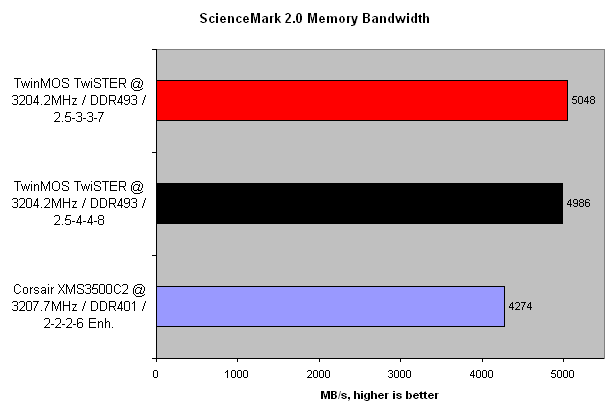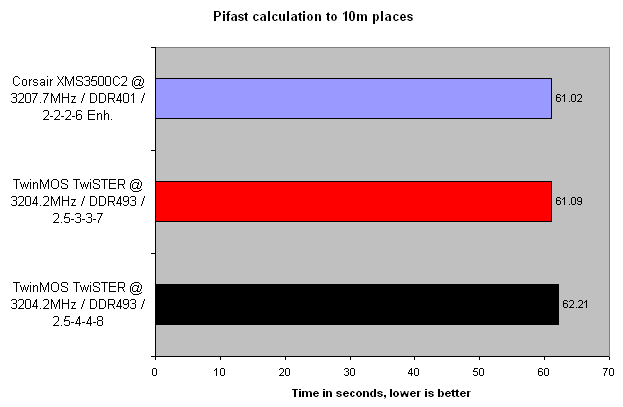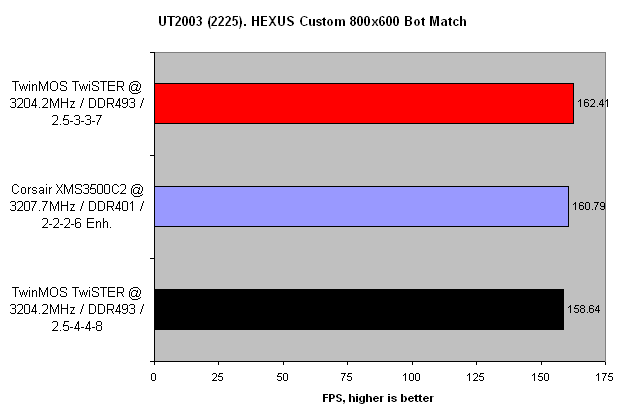Benchmarks
Let's take memory bandwidth into account first. Surely a situation where RAM running at DDR493 speeds will excel in.
Evidently so. ScienceMark confirms what we already know. There's more bandwidth at higher DRAM speeds. Is it really as simple as that, that more bandwidth makes a better module ?. If only that inference was correct. We'd not need to take account of other performance parameters such as latencies and chip densities, then. Or next examination would fall on latencies. That's the kind of situation where the TwinMOS modules should look poorer in relation the low latency Corsair.
We'd normally include a latency graph next. However, ScienceMark 2.0 behaved erratically when calculating latency cycles for the TwinMOS TwiSTER RAM. We aim to provide consistent, repeatable results that you should be able to reproduce with the same hardware. Due to the results deviation in the test, it was decided to forego latency analysis. Whilst the Corsair provided a repeatable reading of around 77 nanoseconds, the TwinMOS ranged from 69 - 91, and that's for the standard 2.5-4-4-8 settings.
Pifast should help clear matters up.

We'd fully expect the TwinMOS when run at 2.5-3-3-7 to be faster than at 2.5-4-4-8 settings. It's the same RAM but with slightly tighter latencies. What we wouldn't really expect is for it to be slower than the Corsair. Why is this the case ?. The answer lies in the pure efficiency of ultra-low latency memory at turning requests into data. What it gives away in size (bandwidth) it makes up for in speed (low latency). The enhanced ABIT Game Accelerator timings also help in boosting performance.

3DMark 2001SE b330 sees it in more or less the same way. Here, bandwidth and a 20%+ higher FSB speed is just a touch more crucial than in Pifast. There's very little in it . Please remember that the TwinMOS TwiSTER RAM is running in a pseudo overclocked 2.6GHz Pentium 4. This is exactly how firms such as Corsair, OCZ and now TwinMOS position premium RAM. In effect, it allows the user to emulate performance that's usually associated higher up the price scale for less. You could of course run the same processor with asynchronous (read slower) RAM, but keeping it all in synch' is a more elegant approach.

Our low detail Unreal Tournament 2003 test involves a bot match at a resolution of 800 x 600. The onus shifts from the graphics card to the subsystem. A faster FSB and memory, albeit with looser timings, manages to equal our default 3.2GHz / Corsair LL combination.

Quake III reiterates that fact. What we see is that just have DDR500 stamped on modules isn't telling us the whole story. Manufacturers will attempt to maximise the attractiveness of their products by exploiting parts of the specification that appeal most to consumers. That's invariably big numbers. DDR500 or PC4000 memory is sure to wow enthusiasts and anyone with a passing interest in PC hardware. It's a marketing game that most memory manufacturers know how to play.









